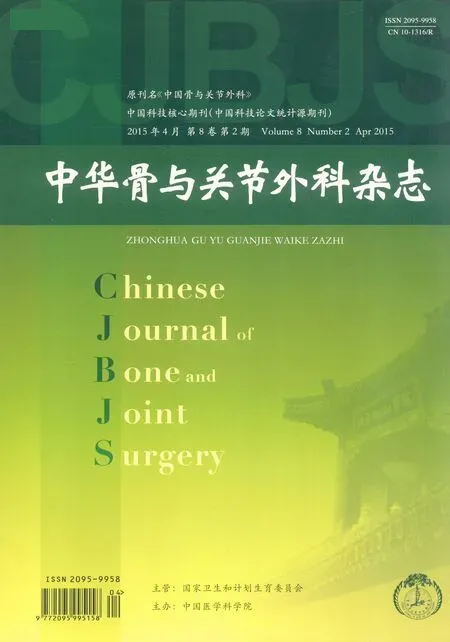颈椎CT在OPLL临床诊治中的运用价值
钟卓霖 胡建华翟吉良
(中国医学科学院北京协和医学院北京协和医院骨科,北京100730)
·综述·
颈椎CT在OPLL临床诊治中的运用价值
钟卓霖 胡建华*翟吉良
(中国医学科学院北京协和医学院北京协和医院骨科,北京100730)
后纵韧带骨化(ossification of the posterior longitudinal ligament,OPLL)在1838年被首次介绍,但直到19世纪60年代才被广泛报道[1]。日本学者依据患者颈椎平片上OPLL的不同特点将其分成四种类型:节段型、连续型、混合型以及局灶型[2]。颈椎平片在OPLL诊治中具有重要的运用价值,如Fujiyoshi等[3]把OPLL患者颈椎曲度及骨化大小合并一起并提出K-line的概念,认为K-line阴性的患者行后路手术术后改善不明显;而且颈椎平片因其单次费用低、放射量较小而方便用于长期随访[4]。当然,临床上MRI对于OPLL患者脊髓受压程度的评估具有不可替代的作用。Matsuyama等[5]依据OPLL患者MRI横断面上脊髓形状将其分为三角形、回行镖形及泪滴形,颈椎后路手术后,三角形患者预后最差,回行镖形次之,泪滴形最好,他们认为术前脊髓三角形、T1低信号、T2高信号以及术后无明显扩张均是预后不良的危险因素。此外,MRI在评估软组织对脊髓的压迫程度时具有明显优势,尤其当OPLL合并颈椎间盘突出时[6]。
然而,通过颈椎平片评估OPLL的特点有诸多不足,比如下颈椎OPLL很有可能被肩部的阴影覆盖(图1A),由于肩部组织的重叠,部分C6及C7椎体在X线片上不能完全显现;在年轻的OPLL患者中,骨化的密度较低,在平片上与周围组织很难区分;有些因急性颈椎损伤而入院的OPLL患者(如中毒、休克、昏迷等)无法行颈椎平片[7];当拍摄颈椎X线片,患者颈部成一定角度旋转时,椎体后缘将出现OPLL的假象(如图1B、图1C示该患者正常拍摄时的颈椎侧位片);另外,虽然OPLL可以向任何方向进展,但在颈椎平片上只有头尾侧及腹背侧能显示出来[8]。Jeon等[9]回顾性分析146例OPLL患者的影像学特点,结果发现19.9%的OPLL患者不能仅通过颈椎平片确认。颈椎MRI在OPLL临床运用中也有其不足,在鉴别骨化或钙化团块时MRI敏感性和特异性低,其更多是用来评估脊髓受压情况或是髓内病灶,如脊髓水肿或软化。
相比而言,颈椎CT在OPLL的诊治中具有明显优势。本文内容包括:颈椎CT在OPLL诊断中的运用、颈椎CT明确是否合并硬膜骨化、三维CT在OPLL中的运用。
1 颈椎CTT在OPLL诊断中的运用
颈椎CT平扫是发现小的骨化或钙化最敏感的一种检测方式,虽然传统的颈椎CT平扫局限于断层的厚薄,单纯依靠颈椎CT平扫很难在相同的水平及角度对OPLL进行过去和现在的比较[8],但依赖于科技的不断发展,目前临床颈椎CT技术可以实现薄层扫面、矢状位及三维重建,这些新技术使我们对OPLL的认识更加清楚及深刻。在判断骨化块厚度、横向伸展以及脊髓可用空间(space available for the cord,SAC)方面,颈椎CT尤其具有重要价值[10]。由日本学者依据颈椎平片提出的OPLL四种分型目前在临床上广泛使用,文献报道该OPLL分型中,节段型占39%,连续型占27%,混合型占29.2%,局灶型占7.5%[9-11]。然而通过颈椎CT矢状位重建,Jeon等[9]报道以上四种分型依次占35.6%、11.6%、38.4%和4.1%,造成二者之间差异的原因,一是相当一部分患者在颈椎侧位片上归为连续型而通过颈椎CT图像分析却为混合型,二是相当一部分患者通过颈椎侧位片未能诊断OPLL,而通过颈椎CT图像却明确为节段型OPLL;此外,他们还发现有11.6%的OPLL患者伴随寰椎横韧带的骨化,而在之前未有报道。Chang等[12]对比108例OPLL患者的颈椎侧位片+颈椎CT轴位片与颈椎CT二维或三维重建片,对患者的OPLL重新分型后发现,前组观察者之内和之间(inter-and intra-observer)的可靠性分别为64%与77%,平均Kappa值分别为0.51、0.67;后组可靠性分别为85%与93%,平均Kappa值分别为0.71、0.85;同时他们还发现在颈椎侧位片上难以区分连续型与混合型OPLL,而通过二维或颈椎三维CT重建技术则容易区分。

图1 A示由于肩部组织的重叠,部分C6及C7椎体在X线片上不能完全显现;图1B示拍摄颈椎X片时颈部成一定角度旋转,椎体后缘出现OPLL的假象;图1C示该患者正常拍摄时的侧位片;图1D示椎体后纵韧带骨化区与硬膜骨化区之间存在低密度影线;图1E示黄韧带骨化
2 颈椎CT明确是否合并硬膜骨化及骨化的形状
硬脊膜的一个重要功能是保护脊髓等神经组织,然而,当硬脊膜骨化时,颈前路术中分离后纵韧带和硬膜时将会变得非常困难,如果外科医生对其缺乏足够的了解,则术中操作可能导致神经组织的严重损伤[13,14]。文献报道OPLL患者合并硬膜骨化行前路减压手术时有更高的硬膜外出血及脑脊液漏的风险[15,16]。Sm ith等[17]提出术前根据颈椎CT表现充分评估是否存在硬脊膜骨化,在术中避开硬脊膜骨化区,只要术中往侧方更广泛的减压就不会因此影响整体减压效果,但可能会由此增加神经血管损伤的风险。所以,术前评估硬膜是否骨化对手术方案的制定具有重要意义。后纵韧带在椎体后缘由C2水平一直延续到骶骨水平,其包含两层结构,表层邻近硬脊膜,连接3~4个椎体;深层靠近椎体,连接邻近两个椎体[15-18]。Hida等[15]根据颈椎CT图像把OPLL合并硬膜骨化分为两型:单层影型和双层影型;单层影型被认为是骨化起自后纵韧带肥厚,由内向外发展,并逐步发展至周围,横断面看像钩形或“C”字型;双层影型OPLL的腹侧骨化层是PLL的深层发生骨化,背侧骨化层是PLL的表层发生骨化。双层影型包含椎体后低密度影线,该低密度影线位于后纵韧带骨化区与硬膜骨化区之间(图1D),双层影型合并更高的硬膜骨化发生率[19];双层影型OPLL高密度块比单层影型厚度更大[13]。颈椎前路减压手术时,当OPLL合并硬膜骨化时术前明确是单层影型还是双层影型对手术方案设计具有重要的价值。双层影型OPLL比单层影型OPLL更容易发生硬脊膜缺损,椎管越窄,其发生硬脊膜损伤的可能性越大[13-15]。仅通过颈椎平片无法明确后纵韧带的骨化块在椎管内的位置以及骨化块的形状特点,颈椎CT可以弥补此不足。OPLL在颈椎CT轴位像上的典型表现为蘑菇型、山丘型以及方形,以后两者常见[18];也有学者将其分为中央型及侧方生长型[20,21]。Matsunaga等[22]认为颈椎CT上表现为侧方型的骨化灶在影像学上是OPLL患者脊髓病变加重的危险因素。轴位像侧方生长型OPLL更易出现脊髓受损病变[20]。
3 三维CT在OPLL OPLL中的运用
Hasegawa和Homma[23]首次运用颈椎三维CT技术研究OPLL。依赖于颈椎三维CT重建技术,有学者对OPLL提出新的分型。Kawaguchi等[2]以颈椎三维CT联合颈椎MRI图像对比颈椎侧位片评估55例OPLL患者的后纵韧带骨化块的特点,他们根据OPLL患者颈椎三维CT图像提出新的分型:平坦型,即后纵韧带的骨化块沿着椎体后缘边界及椎间盘水平纵向平缓延伸,骨化的宽度超过50%的椎管容积,其长度超过连续的3个椎体水平;不规则型,即存在不规则的骨化,且这些骨化区位于椎管两侧而不是中间,或者骨化是双层形状,其宽度小于50%的椎管容积,长度超过连续的3个椎体水平;局限型,即骨化只限于椎体后壁水平,或者其长度不超过连续的3个椎体水平;此外,他们还发现OPLL的骨化在轴位水平其宽度在双侧Luschka关节内,而其长度不会超过齿状突水平,这与后纵韧带在解剖学上的范围在双侧Luschka关节内相符[24]。Fujimori等[8]通过颈椎三维CT成像技术对20例连续型OPLL患者共100个节段进行分析,结果发现连续型OPLL可以分成桥接型
及非桥接型两类:前者为连续的后纵韧带骨化连接着椎体后壁及椎间隙,其前屈后伸位椎间活动度(range ofmotion,ROM)平均为0.3°,旋转活动度为0.2°;后者为在后纵韧带骨化之间或骨化的后纵韧带与椎体之间存在细小的间隙,其前屈后伸位椎间活动度平均为4.9°,旋转活动度为0.2°。此外,他们还提出“石笋型”OPLL,与非桥接型OPLL相比,前者椎间ROM较小(平均1.6°),但旋转活动度却相当(平均4.6°)。颈椎CT也可用于随访。Fujimori等[8]通过颈椎三维CT成像技术观察OPLL患者术前及后路椎板成形术后骨化区的进展情况,随访3年,结果发现椎板成形术后OPLL以平均最大每年1.5mm的速度进展,平均最大进展长度4.7mm。
4 其他
Kotani等[25]通过颈椎CT图像,发现2例OPLL合并黄韧带骨化的患者,拓宽了大家对OPLL的进一步认识,本文图1E中颈椎CT轴位片示黄韧带骨化。近期,有学者报道通过动力位CT造影技术,发现节段型与混合型OPLL患者的脊髓在后伸位时受压加重;骨化块椎管占有率高时,患者在颈椎屈曲位时亦能导致脊髓受压;此外,临床上部分OPLL患者,中立位时影像学上提示脊髓受压并不重,但症状却逐渐进展,这被认为与脊髓在动力位受压密切相关,此时动力位CT造影技术可以发挥重要作用[26];此外,文献报道CT在诊断颈椎损伤时其敏感性和特异性分别为90.9%、100%,对于有临床意义的颈椎损伤,其敏感性和特异性均为100%[27],当患者颈椎遭受严重损伤,外伤后颈部疼痛、活动受限,怀疑有颈椎骨折或小关节脱位以及外伤后因四肢瘫痪而不能行颈椎X线片检查时,应考虑行颈椎CT检查[27-30]。
尽管颈椎平片及MRI在OPLL患者的诊治中有重要作用,但颈椎CT在OPLL的临床运用价值不可替代,其在OPLL的临床诊断、分型、术前手术方案的制定及术后随访都具有重要价值,合理运用颈椎CT技术不仅可以加深对OPLL的认识,更可以方便有效地诊治OPLL,相信颈椎CT在OPLL中的临床运用将会越来越广泛。
[1]Trojan DA,Pouchot J,Pokrupa R,etal.Diagnosisand treatment of ossification of the posterior longitudinal ligament of the spine:reportof eightcases and literature review.Am JM ed,1992,92(3):296-306.
[2]Kawaguchi Y,Urushisaki A,Seki S,etal.Evaluation of ossification of the posterior longitudinal ligamentby three-dimensional computed tomography and magnetic resonance imaging.Spine J,2011,11(10):927-932.
[3]Fujiyoshi T,YamazakiM,Kawabe J,et al.A new concept for making decisions regarding the surgical approach for cervical ossification of the posterior longitudinal ligament: the K-line.Spine(Phila Pa 1976),2008,33(26):E990-E993.
[4]Kudo H,Yokoyama T,Tsushima E,etal.Interobserver and intraobserver reliability of the classification and diagnosis for ossification of the posterior longitudinal ligamentof the cervical spine.Eur Spine J,2013,22(1):205-210.
[5]Matsuyama Y,Kawakam iN,Yanase M,etal.Cervicalmyelopathy due to OPLL:clinicalevaluation by MRIand intraoperative spinal sonography.JSpinal Disord Tech,2004,17 (5):401-404.
[6]Yang HS,Chen DY,Lu XH,et al.Choice of surgical approach for ossification of the posterior longitudinal ligament in combination with cervical disc hernia.Eur Spine J, 2010,19(3):494-501.
[7]Richards PJ.Cervical spine clearance:a review.Injury, 2005,36(2):248-269.
[8]Fujimori T,Iwasaki M,Nagamoto Y,et al.Three-dimensionalmeasurement of grow th of ossification of the posterior longitudinal ligament.JNeurosurg Spine,2012,16(3): 289-295.
[9]Jeon TS,Chang H,Choi BW.Analysis of demographics, clinical,and radiographical findingsof ossification of posterior longitudinal ligamentof the cervical spine in 146 Korean patients.Spine(Phila Pa 1976),2012,37(24):E1498-E1503.
[10]Sohn S,Chung CK,Yun TJ,et al.Epidemiological survey of ossification of the posterior longitudinal ligament in an adult Korean population:three-dimensional computed tomographic observation of 3,240 cases.Calcif Tissue Int, 2014,94(6):613-620.
[11]M izuno J,Nakagawa H.Ossified posterior longitudinal ligament:management strategies and outcomes.Spine J,2006, 6(6Suppl):282S-288S.
[12]Chang H,Kong CG,Won HY,etal.Inter-and intra-observer variability of a cervical OPLL classification using reconstructed CT images.Clin Orthop Surg,2010,2(1):8-12.
[13]M in JH,Jang JS,Lee SH.Significance of the double-and single-layer signs in theossification of the posterior longitudinal ligamentof the thoracic spine.Neurosurgery,2007,61 (1):118-121.
[14]Chen Y,Guo Y,Chen D,etal.Diagnosis and surgery of ossification of posterior longitudinal ligamentassociated w ith dural ossification in the cervical spine.Eur Spine J,2009, 18(10):1541-1547.
[15]Hida K,IwasakiY,Koyanagi I,etal.Bonewindow comput-
ed tomography for detection of duraldefectassociated with cervical ossified posterior longitudinal ligament.Neurol Med Chir(Tokyo),1997,37(2):173-175.
[16]Saetia K,Cho D,Lee S,etal.Ossification of the posterior longitudinal ligament:a review.Neurosurg Focus,2011,30 (3):E1.
[17]Sm ith ZA,Buchanan CC,Raphael D,et al.Ossification of the posterior longitudinal ligament:pathogenesis,management,and current surgical approaches.A review.Neurosurg Focus,2011,30(3):E10.
[18]Soo MY,Rajaratnam S.Symptomatic ossification of the posterior longitudinal ligament of the cervical spine:pictorialessay.AustralasRadiol,2000,44(1):14-18.
[19]Epstein N.Identification of ossification of the posterior longitudinal ligament extending through the dura on preoperative computed tomographic examination of the cervical spine.Spine(Phila Pa1976),2001,26(2):182-186.
[20]M atsunaga S,Nakamura K,Seichi A,et al.Radiographic predictors for the development of myelopathy in patients w ith ossification of the posterior longitudinal ligament:a multicenter cohort study.Spine(Phila Pa 1976),2008,33 (24):2648-2650.
[21]Kawaguchi Y,Matsumoto M,IwasakiM,etal.New classification system for ossification of the posterior longitudinal ligament using CT images.JOrthop Sci,2014,19(4):530-536.
[22]Matsunaga S,Nakamura K,Seichi A,et al.Radiographic predictors for the development of m yelopathy in patients w ith ossification of the posterior longitudinal ligament:a multicenter cohort study.Spine(Phila Pa 1976),2008,33 (24):2648-2650.
[23]Hasegawa K,Homma T.Morphologic evaluation and surgical simulation of ossification of the posterior longitudinal ligamentusing helical computed tomography with three-dimensional and multiplanar reconstruction.Spine(Phila Pa 1976),1997,22(5):537-543.
[24]Saifuddin A,Green R,White J.Magnetic resonance imaging of the cervical ligaments in the absence of trauma. Spine(Phila Pa1976),2003,28(15):1686-1691.
[25]Kotani Y,Takahata M,Abum i K,et al.Cervicalmyelopathy resulting from combined ossification of the ligamentum flavum and posterior longitudinal ligament:report of two casesand literature review.Spine J,2013,13(1):e1-e6.
[26]Yoshii T,Yamada T,HiraiT,etal.Dynam ic changes in spinal cord compression by cervical ossification of the posterior longitudinal ligament evaluated by kinematic com puted tomography myelography.Spine(Phila Pa 1976),2014,39 (2):113-119.
[27]Resnick S,Inaba K,Karamanos E,et al.Clinical relevance ofmagnetic resonance imaging in cervical spine clearance: a prospective study.JAMA Surg,2014,149(9):934-939.
[28]K ligman M,VasiliC,Roffman M.The role of computed tomography in cervical spinal injury due to diving.Arch Orthop Trauma Surg,2001,121(3):139-141.
[29]Payabvash S,M cKinney AM,M cKinney ZJ,et al.Screening and detection of blunt vertebral artery injury in patients w ith upper cervical fractures:the role of cervical CT and CT angiography.Eur JRadiol,2014,83(3):571-577.
[30]Ding A,Abujudeh H,Novelline RA.Diagnosing cervical spine instability:role of the post-computed tomography scan out-of-collar lateral radiograph.JEmerg Med,2011,40 (5):518-521.
2095-9958(2015)04-0 169-04
10.3969/j.issn.2095-9958.2015.02-016
*通信作者:胡建华,E-mail:jianhuahu001@126.com

